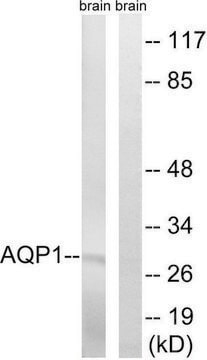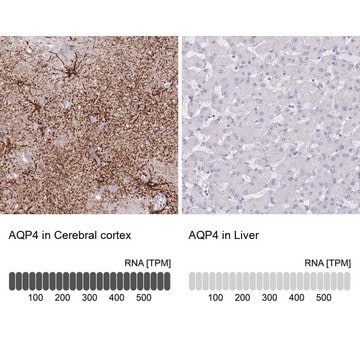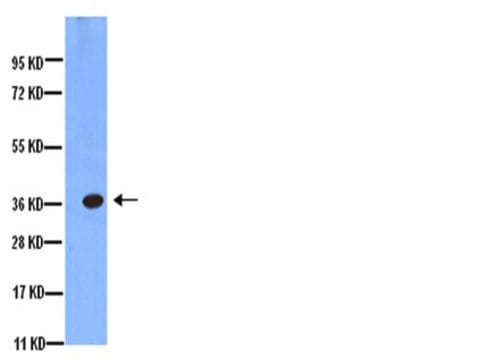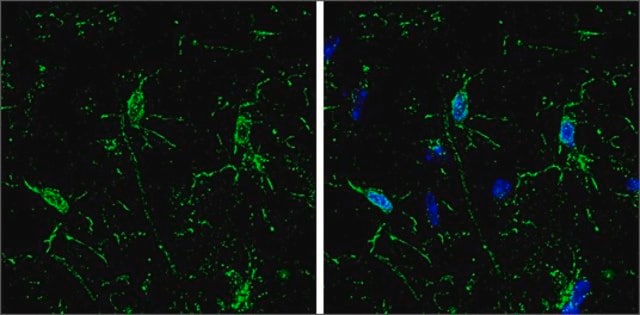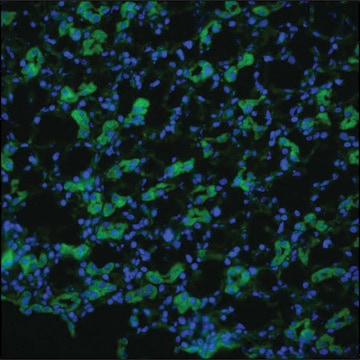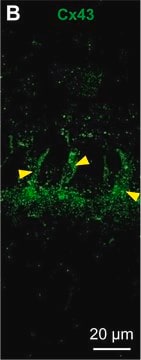As recommended in the Properties section under technique(s), the suggested dilution factors are as follows:
IHC (Immunohistochemistry) - 1:2500 - 1:5000
WB (Western Blot) - 0.04 - 0.4 µg/mL
ICC-IF (Immunofluorescence) - 0.25 - 2 µg/mL
Please review the Certificate of Analysis for lot-specific values.
HPA014784
Anti-Aquaporin-4 Antibody

Prestige Antibodies® Powered by Atlas Antibodies, rabbit polyclonal
Sinônimo(s):
Anti-AQP-4, Anti-Aquaporin-4, Anti-MIWC, Anti-Mercurial-insensitive water channel, Anti-WCH4
About This Item
IHC
immunofluorescence: 0.25-2 μg/mL
immunohistochemistry: 1:2500-1:5000
Produtos recomendados
Nome do produto
Anti-AQP4 antibody produced in rabbit, affinity isolated antibody, Prestige Antibodies® Powered by Atlas Antibodies, buffered aqueous glycerol solution
fonte biológica
rabbit
Nível de qualidade
conjugado
unconjugated
forma do anticorpo
affinity isolated antibody
tipo de produto de anticorpo
primary antibodies
clone
polyclonal
linha de produto
Prestige Antibodies® Powered by Atlas Antibodies
Formulário
buffered aqueous glycerol solution
reatividade de espécies
human, mouse
validação aprimorada
orthogonal RNAseq
Learn more about Antibody Enhanced Validation
técnica(s)
immunoblotting: 0.04-0.4 μg/mL
immunofluorescence: 0.25-2 μg/mL
immunohistochemistry: 1:2500-1:5000
sequência de imunogênio
CPDVEFKRRFKEAFSKAAQQTKGSYMEVEDNRSQVETDDLILKPGVVHVIDVDRGEEKKGKDQSGEVLSSV
nº de adesão UniProt
Condições de expedição
wet ice
temperatura de armazenamento
−20°C
modificação pós-traducional do alvo
unmodified
Informações sobre genes
human ... AQP4(361)
Descrição geral
Imunogênio
Aplicação
The Human Protein Atlas project can be subdivided into three efforts: Human Tissue Atlas, Cancer Atlas, and Human Cell Atlas. The antibodies that have been generated in support of the Tissue and Cancer Atlas projects have been tested by immunohistochemistry against hundreds of normal and disease tissues and through the recent efforts of the Human Cell Atlas project, many have been characterized by immunofluorescence to map the human proteome not only at the tissue level but now at the subcellular level. These images and the collection of this vast data set can be viewed on the Human Protein Atlas (HPA) site by clicking on the Image Gallery link. We also provide Prestige Antibodies® protocols and other useful information.
Ações bioquímicas/fisiológicas
Características e benefícios
Every Prestige Antibody is tested in the following ways:
- IHC tissue array of 44 normal human tissues and 20 of the most common cancer type tissues.
- Protein array of 364 human recombinant protein fragments.
Ligação
forma física
Informações legais
Exoneração de responsabilidade
Não está encontrando o produto certo?
Experimente o nosso Ferramenta de seleção de produtos.
Código de classe de armazenamento
10 - Combustible liquids
Classe de risco de água (WGK)
WGK 1
Equipamento de proteção individual
Eyeshields, Gloves, multi-purpose combination respirator cartridge (US)
Escolha uma das versões mais recentes:
Já possui este produto?
Encontre a documentação dos produtos que você adquiriu recentemente na biblioteca de documentos.
Os clientes também visualizaram
-
How can I find a Specification/description PDF hat contains suggested dilutions, images of Westernblots and IF and Histochemistry to download for this antibody? Anti AQP4 HPA014784
1 answer-
Helpful?
-
-
Does the AQP4 antibody bind to intracellular or extracellular domain of the protein
1 answer-
The antigen this antibody is raised against is the last 72 aa residues in the AQP4 protein sequence. This peptide is available as product APREST73067 https://www.sigmaaldrich.com/US/en/product/sigma/aprest73067. According to Uniprot, this is located on a cytoplasmic region of the protein. https://www.uniprot.org/uniprotkb/P55087/feature-viewer.
Helpful?
-
Active Filters
Nossa equipe de cientistas tem experiência em todas as áreas de pesquisa, incluindo Life Sciences, ciência de materiais, síntese química, cromatografia, química analítica e muitas outras.
Entre em contato com a assistência técnica